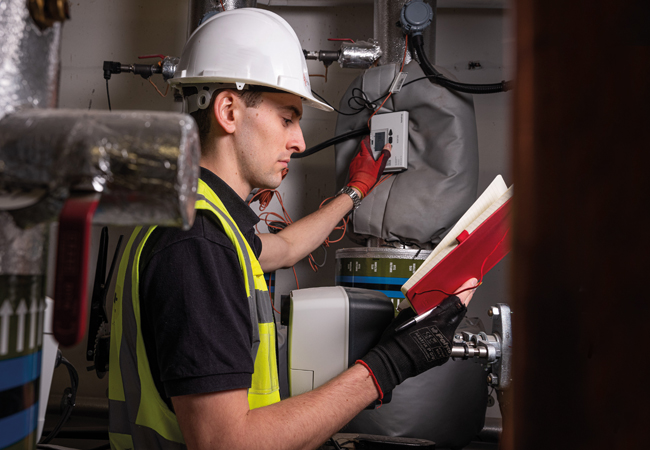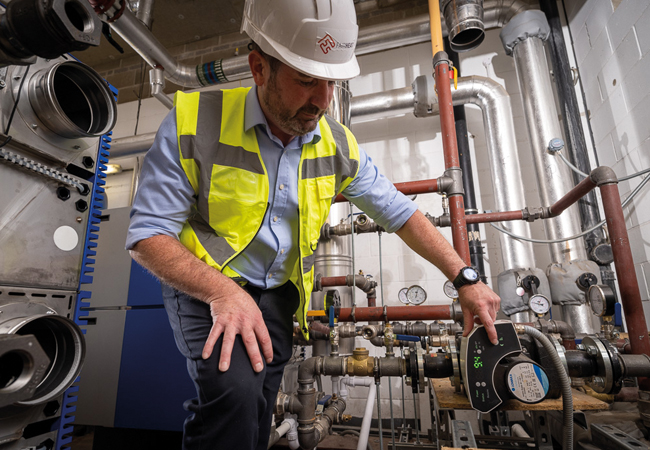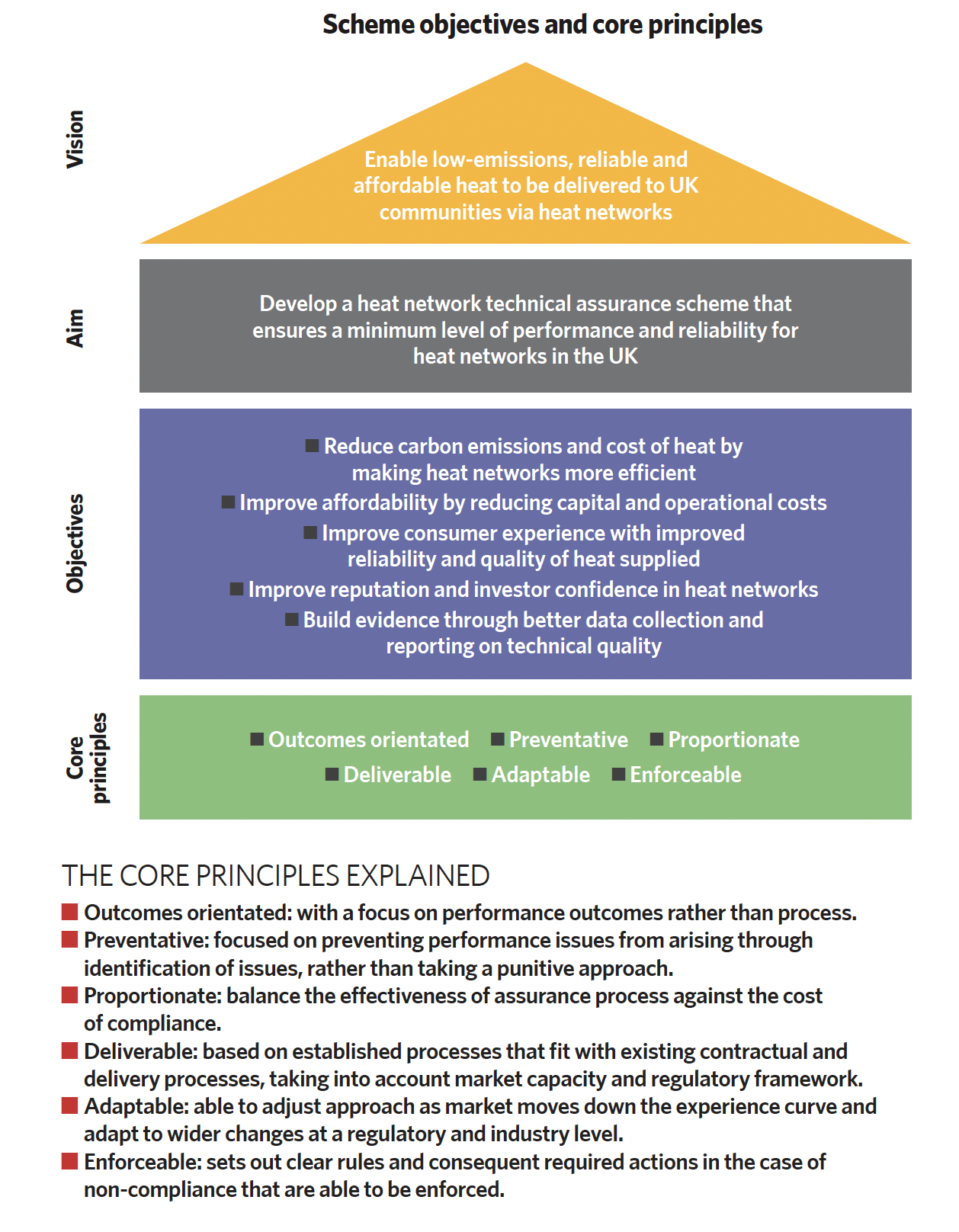
Heat is a utility, and we’re just about to regulate it. By 2024, the aim is that heat will be on a comparable regulatory footing to electricity and gas. Ofgem will be the regulator and there will be statutory technical standards in place to underpin heat networks in the form of a Technical Assurance Scheme (HNTAS).
Designers will have to produce better designs, contractors will install better networks, and operators will have to improve in-use performance. Ultimately, however, the key issue is to improve customer outcomes through the certification (assurance) of heat networks. Things are moving rapidly in the heat network sector.
In 2010, it was realised that heat networks were in the Wild West – no rules and no sheriff in town. We then put CP1 (2015) in place and moved on to a major update in CP1 (2020), which really brought the laws to town. But these are still voluntary! Although the majority of the industry is beginning to use CP1, the Marshall is still not fully in charge. The Department for Energy Security and Net Zero (DESNZ) and Ofgem are now introducing real regulation, potentially with big effect.
Heat networks are a key part of the government’s strategy to reach net zero emissions by 2050, and the market is set to grow rapidly. The government is encouraging its growth with financial support and a new regulatory regime in the Energy Bill, currently passing through parliament. All this recognises the Climate Change Committee’s recommendation that around 18% of UK heat should come from heat networks by 2050. They currently provide about 2-3%.
HNTAS will underpin this regulation to ensure a minimum level of performance and reliability for heat networks, leading to good consumer outcomes. Work has begun to determine the necessary governance structures, technical specifications and procedures that will be required to meet the aims for the scheme. Good progress has already been made to design and develop a scheme that will provide credible assurance of heat network quality and performance, and demonstrate compliance with technical standards.

Certain performance outcomes will have to be achieved and maintained
Assurance through certification
HNTAS will heavily reference CIBSE/ADE CP1 Heat Networks Code of Practice (2020), which has gained huge consensus across the sector. This is voluntary, however, and will move to a mandatory assurance regime that will form part of the regulatory requirements. Prime objectives of HNTAS are to improve the efficiency and reliability of heat networks to reduce carbon emissions and the costs of heat supplied to consumers. The core principles are that the scheme be outcomes focused, preventative, proportionate, deliverable, adaptable and enforceable.

Significant engagement with working groups has already begun to gain widespread buy-in to the scheme rules and pathways to regulatory implementation.Good progress has been made in setting out the constituent parts of a heat network and underlying elements to be included within the assurance scheme. Heat networks are complex systems, with multiple constituent parts that are often designed, built, owned and operated by different parties. The assurance scheme needs to recognise this.
HNTAS will build on established technical standards, such as CP1 (2020), but will also develop standardised processes for demonstrating compliance with established and agreed technical standards. Research, analysis and industry engagement is under way to identify and agree which established standards should be in scope of the quality assurance scheme, and whether amendments or additions are required.
Another good example of standards that might underpin HNTAS is the forthcoming major update of the Building Engineering Services Association (BESA) Testing Regime for heat interface units (HIUs), which will include pass and fail thresholds, leading to registered HIUs.
HNTAS will provide Ofgem with a means to identify whether heat network operators are compliant with the mandated standards – for example, through certification. It will also give clear accountabilities for requirements and performance, improving confidence in the sector, including at handover points in the heat network development process. In summary, HNTAS is to be a performance-based assurance scheme so that an independent assessment can be made on claims by a responsible party as to whether minimum standards will be achieved (validation) – for example, during design and construction – or have been achieved (verification), for example, during operation. Ultimately, to ensure that certain performance outcomes are achieved and maintained.

Scope of HNTAS
HNTAS must accommodate all heat networks, from single-building ‘communal’ networks up to large ‘district’ heat networks supplying multiple buildings. It is also envisaged that different elements within a heat network will need to be assessed, along with whoever the responsible parties may be at different stages of the development life-cycle. This will need to take into account responsible parties and elements including operating temperature, development type, building connections, hydraulic separation, and configuration of heat sources.
The HNTAS development project is expected to last throughout 2023 into early 2024. It will produce a final report based on normative documents, setting out what technical requirements are in scope, and explanatory reports that set out the rationale for design choices.
Future outputs
Normative documents: these set out which technical requirements are in scope, how compliance with these requirements is demonstrated, and the procedures for how the regime operates, including roles and responsibilities of different organisations.
Explanatory reports: these underpin the normative documents, setting out the rationale for the design choices and any further guidance on interpretation/application of the normative documents. HNTAS workstreams and reports are split between technical specification, and those related to procedures and processes for the assurance scheme.
Final HNTAS report: an integrated final report to collate all the work, with recommendations on the pathway from the scheme design to operation, to its application in practice and in regulation. This will include recommendations about the overall governance and operation of the future scheme. Also providing justification and explanation of the recommended scheme design, with the recommended pathway from scheme design to implementation in regulation.
Conclusions
The introduction of procedures for certification and setting minimum technical standards is a key part of moving to a regulatory framework. Heat networks are often large, complex projects, with multiple stages and actors, and long timescales, which suggests staged certification would be most appropriate. Certifying heat networks that meet the minimum standards will raise performance throughout the sector, and the assurance scheme will give network developers and operators confidence to invest in the sector.
Engagement with stakeholders throughout development of HNTAS is essential to get buy-in for the assurance scheme. It must also be designed to dovetail into the future regulatory framework and, in particular, with heat network zoning.
The heat networks sector is growing rapidly, with 50,000 residential HIUs installed every year. This assurance scheme will help it grow into a regulated utility, giving confidence to developers and investors. A lack of skills and resources in this sector is a whole other issue, for another article, but if you want to work in a vibrant growth area, contributing to net zero, this is the one. The Marshall is coming to town and bringing new heat network laws. Prepare!
- A more extensive paper was presented at the CIBSE ASHRAE Technical Symposium
About the authors:
Professor Phil Jones, visiting professor at London South Bank University, is supporting the DESNZ HNTAS team, as is Gareth Jones, MD at FairHeat, and technical author of the scheme. Freddie Valletta is a senior engineer and Lucy Sherburn a consulting engineer, both at FairHeat
